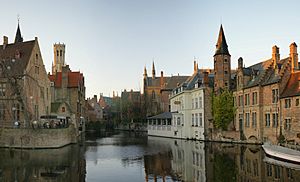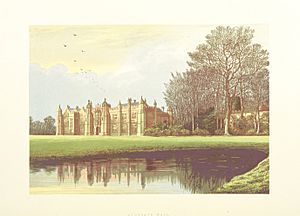Mother Mary More facts for kids
Mary More (1732–1807) was a strong leader during a time of big changes. She was born in Barnborough, Yorkshire. Mary was the last direct family member of the famous Sir Thomas More.
She is best known for being the seventh Prioress, or leader, at the Priory of Nazareth. Mother More guided her community of nuns through many difficult times. These challenges happened during the rule of Emperor Joseph II and the big changes of the French Revolution.
Contents
Life at the Priory of Nazareth
Mary More joined the Priory of Nazareth in Bruges in 1753. She made her first promises to the community that year. Later, in 1766, she became the Prioress. She took over from Mother Olivia Darrell.
The main job of the nuns, called canonesses, was to provide education. The Priory of Nazareth was like a boarding school for girls. It was similar to the Jesuit College for boys in Saint-Omer.
The convent was also involved in politics during the 1700s. They gave money to Prince Charles Edward Stuart. He was trying to get back the English Throne in 1745. They also supported the Patriots of Brabant. These patriots were fighting against Emperor Joseph II.
Facing the First Big Challenge
In September 1772, Emperor Joseph II's government started to close Jesuit schools. This happened after Pope Clement XIV decided to suppress the Society of Jesus. In October, Imperial Commissioners took over the Jesuit colleges.
They held the teachers and leaders. Lay brothers, who were not priests, could either stay or leave the town. Many lay brothers chose to leave. Mother More gave them a place to stay for the night. They left town the next day.
Mother More also had to send away two people from other religious groups. They had come to her for safety. In 1781, Joseph II took control of other convents in Bruges. These included the Carmelites and Carthusians. However, Mother More's convent was partly safe. This was because it was also a school.
Later, some Jesuits were told to go back to England. Three of them were held captive. Mother More helped these hostages. She gave them money and information. She even helped them escape back to England.
In 1783, Mother More was questioned about helping the hostages. She was asked about money from the closed colleges. It was common for nuns in charge to be questioned about their community's money. After the questioning, the commissioners asked to see the convent's inventory. Mother More refused, and they did not come back.
In 1784, Mother More helped members of two other convents. These were the Penitents and the Nuns of Bethania. Mother More's strong leadership helped her community survive. It was the only English convent left in mainland Europe.
More Challenges: 1790 to 1802
In November 1790, the Patriots of Brabant freed Bruges from Imperial forces. But soon, the Emperor took control again. Joseph II was then followed by his brother, Leopold II. Bruges stayed under Imperial control until 1792. That year, the French Revolutionary Army invaded and took over.
Mother More gave shelter to French refugees. These included a priest and four Benedictine nuns. Mother More relied on help from General O’Maron. He was an Irishman serving in the French army.
On Easter Sunday 1793, the Imperial army took Bruges back. There was a short time of peace. England and France were at war. The nuns worried that the French might take Bruges again. So, Mother More made sure her community was ready to leave.
When they heard the French army was coming, the community left the convent. They hoped to escape to England. But as they left, the nuns learned the French planned to use the convent as a hospital. Mother More sent four nuns back. They went to keep control of the convent. In the end, the French did not take the convent or Bruges.
Victory did not last long for Mother More's community. When the French took Ypres, the nuns were told to flee. They were encouraged to go to the Antwerp convent. They were told to leave the older, slower nuns behind. Mother More would not leave them. She gave them the choice to go to Antwerp or stay. Those who stayed were put in the care of Sr. Olivia Darrell. She was the former Prioress.
Life in Exile
More and the rest of the community traveled for seven days. Mother More had looked for places to stay in England before they left. But she had not found one right away. During their first few weeks in London, the nuns stayed in different homes. Relatives of the community mostly took them in.
Mother More said they needed a "retreat that was discreet, permanent, and secure." They eventually settled at Hengrave Hall in Suffolk. This hall was near Bury St. Edmunds. Sir Thomas Gage owned it. Gage's aunt had been a member of the community. She had passed away in 1772. Gage charged Mother More £60 per year for rent.
Mother More was very happy with the place. She said the house felt like a convent. It had cloisters downstairs and galleries upstairs. Mother More and the community started furnishing the house. They made beds and furniture. The house did not have direct water access. The nuns had to take turns carrying water from horse ponds.
Once they were settled, Mother More tried to contact the nuns who stayed behind. She found out that Bruges was full of French troops. The nuns there could not leave or send messages. Before learning this, More had sent £125 for their safe trip to London. But the money never reached them.
It took a year for the nuns to have normal office times. They were also allowed to wear their habits again. To do this, Mother More needed permission. She got it from the Archbishop of Canterbury and two members of parliament. The nuns could not worship openly. This was because Catholicism was not allowed in England. This rule dated back to Henry VIII.
In the summer of 1795, Hengrave Hall was renovated. Sir Thomas Gage helped, and Mother More urged the work. They improved the chapel. Donations started coming in from local people. They gave an organ, candlesticks, food, wine, and cooking supplies. They also gave money for habits. The local people were very kind. They respected the nuns greatly.
Mother More went against the order's rules. Nuns were not supposed to work for people outside the convent. But she did so to pay for things they needed and for rent. She believed it was right to do this. The nuns would embroider and make pincushions. In 1795, they earned £50. In 1796, they earned £113. As life became more normal, the nuns decided to reopen their school. They only had two students at first.
Mother More was key in getting things organized at Hengrave. She helped make life as normal as possible. In January 1796, More went to the Quarter Sessions in Bury. There, she took an oath. This was required by a law from 1791. It allowed her to set up a school and a Catholic chapel.
She had also written to the leaders of the Bruges Diocese. She asked for permission for the sisters who stayed there to travel to England. Most of those nuns eventually came to Hengrave. However, some died soon after the trip.
In the years that followed, some students of the convent made their first promises. But laws from Charles II in 1660 were still in place. These laws re-established the Church of England. Government officials asked if the convent had new members. This was not allowed. Many convents went against the law. They continued teaching and growing their community. This was not unusual for Mother More's time.
Returning to Bruges
In March 1802, the Peace of Amiens was signed. This treaty was between Napoleon and the British government. It meant that Christianity was now accepted in France. Mother More had to decide whether to go back to Bruges or stay at Hengrave Hall.
More held a vote to decide. Twenty out of twenty-five nuns voted to return. A local newspaper announced the nuns' departure with sadness. Local people would miss the nuns and Mother More.
On their journey back, no one would let Mother More pay for lodging. This showed how much they respected her. When they returned to Bruges, Mother More and her community were welcomed warmly. People chanted, "long live the Nuns!" Even with the warm welcome, Mother More's community had to slowly get back their status. They had to follow the new French laws.
Death and Legacy
In her final year, Mother More spent her time praying and reading. She also did needlework. She continued until her hands were too weak to hold the needle. Mother More received her Last Rites on March 5, 1807. She passed away later that month.
The convent's records say that Mother More was very smart. She could understand big things and small ones. She could easily adjust to any situation. She also had a good sense of humor, like her famous ancestor, St. Thomas More.
Francis Young wrote that Mother More's memory lives on. Her community's struggle to keep their way of life was heroic. This memory is kept alive in both Bruges and Hengrave.



